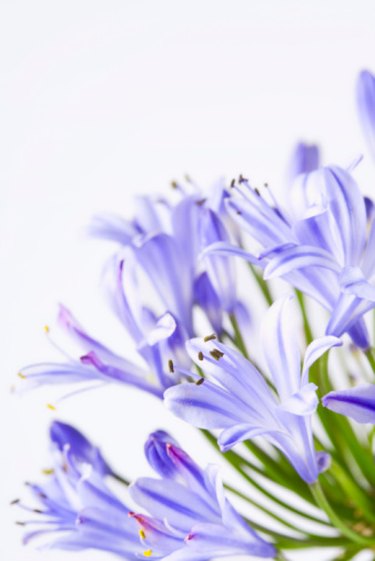Things You'll Need
Organic mulch
Slow-release fertilizer

Lily of the Nile (Agapanthus sp.), a perennial flowering plant also known as African lily, produces blue, trumpet-shaped blooms atop tall flower stalks during the summer and early fall. The plant thrives in U.S. Department of Agriculture hardiness zones 8 through 11, where the climate resembles that of South Africa, the lily of the Nile's place of origin. Tolerant of neglect and poor conditions, the lily of the Nile requires only minimal care to thrive. However, the plant cannot survive cold temperatures and must be grown in containers for overwintering indoors in cooler zones.
Step 1
Plant lily of the Nile in spring after all threat of frost has passed. Choose a planting site that has moist soil of average fertility and receives full sun. The plant can tolerate some afternoon shade, if necessary. Space lily of the Nile plants at least 18 to 24 inches apart.
Video of the Day
Step 2
Water your lily of the Nile plants about once a week during active growth in the spring and summer, or often enough to keep the soil moist at all times. Reduce watering to once every two weeks in fall, and cease watering completely during winter dormancy. Soak the soil to a depth of at least 18 inches at each watering.
Step 3
Apply a 2- to 4-inch layer of organic mulch to the ground around your lily of the Nile plants in late summer or early fall. Mulching protects the roots against cold winter temperatures. In zones where temperatures do not dip below freezing, however, mulching is optional.
Step 4
Feed the lily of the Nile once a year in late spring using a slow-release 5-10-5 or 6-12-6 NPK fertilizer according to the manufacturer's directions. Water the plant thoroughly after applying the fertilizer to help distribute the nutrients throughout the soil and prevent root burn.
Step 5
Remove spent flower stems from your lily of the Nile plants to promote continuous blooming throughout the spring and summer months. Cut back to the ground leaves that have been damaged by frost in late fall or early winter. New growth will begin again in early spring.
Tip
Established lily of the Nile plants will tolerate drought, but they bloom most profusely when provided with ample moisture during active growth.
Pecan shells and shredded bark make ideal mulches for lily of the Nile.
Grow lily of the Nile plants in containers in zones above 8. Plant each rhizome 1/2-inch below the soil surface in spring. Place the container in an outdoor area that receives full morning sun and light afternoon shade. Water once or twice a week to keep the soil moist and feed with an all-purpose liquid fertilizer just after growth begins. Move the container to a frost-free area that receives bright light before the first frost of fall to overwinter indoors. Water once a month to prevent wilting and place the container back outdoors in spring after the threat of frost passes.
Video of the Day